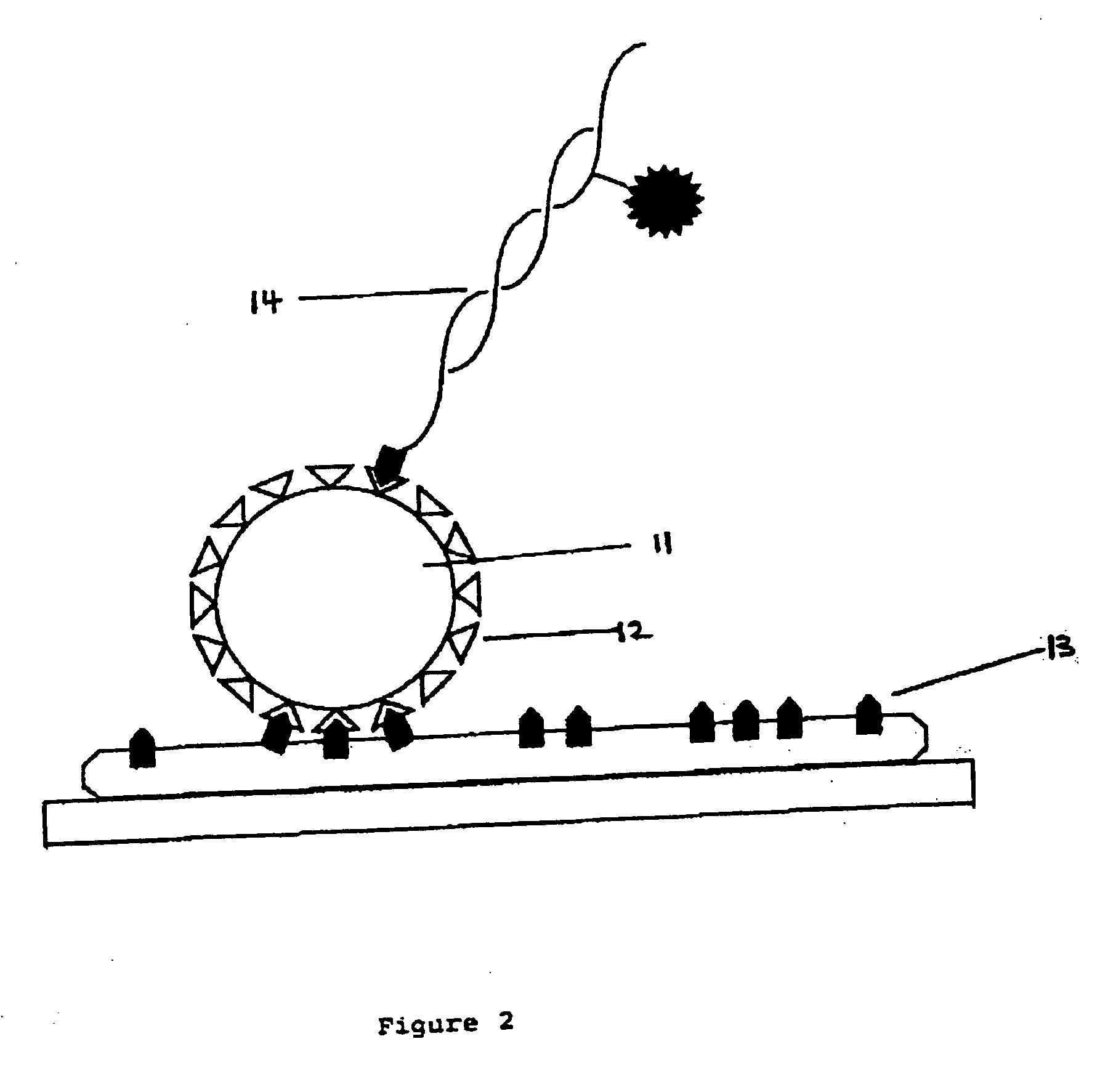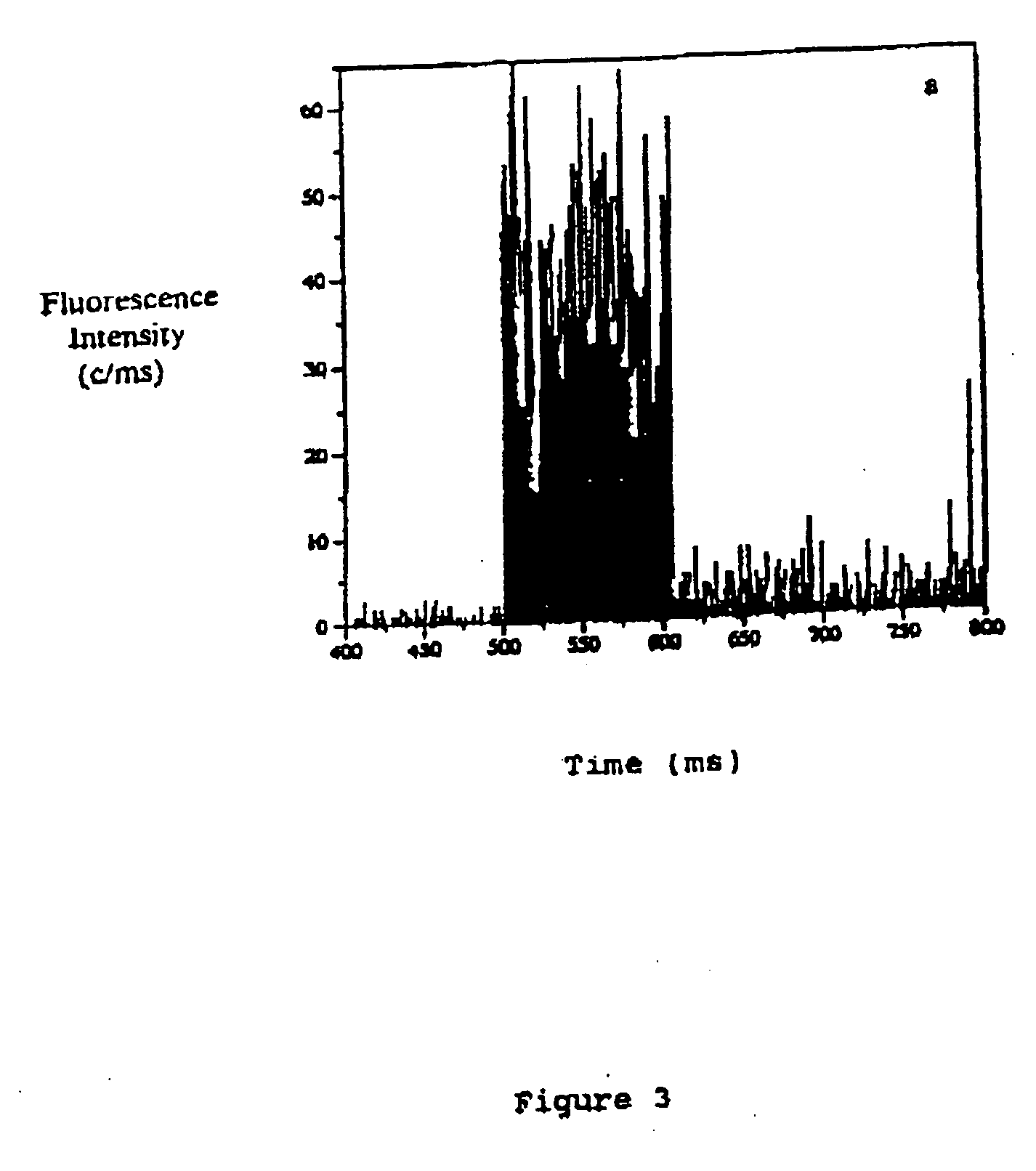Arrayed biomolecules and their use in sequencing
a biomolecule and array technology, applied in the field of arrays of molecules, can solve the problems of phasing problems, inability to sequence long stretches, and inability to freely access dna for interacting with other components, so as to improve the efficiency of sequencing procedures and reduce background interferen
- Summary
- Abstract
- Description
- Claims
- Application Information
AI Technical Summary
Benefits of technology
Problems solved by technology
Method used
Image
Examples
example 1
[0090] The microscope set-up used in the following Example was based on a modified confocal fluorescence system using a photon detector as shown in FIG. 1. Briefly, a narrow, spatially filtered laser beam (CW Argon Ion Laser Technology RPC50) was passed through an acousto-optic modulator (AOM) (A.A Opto-Electronic) which acts as a fast optical switch. The acousto-optic modulator was switched on and the laser beam was directed through an oil emersion objective (100×, NA=1.3) of an inverted optical microscope (Nikon Diaphot 200) by a dichroic beam splitter (540DRLP02 or 505DRLP02, Omega Optics Inc.). The objective focuses the light to a diffraction-limited spot on the target sample immobilised on a thin glass coverslip. Fluorescence from the sample was collected by the same objective, passed through the dichroic beam splitter and directed through a 50 μm pinhole (Newport Corp.) placed in the image plane of the microscope observation port. The pinhole rejects light emerging from the sa...
example 2
[0097] This Example illustrates the preparation of single molecule arrays by direct covalent attachment to glass followed by a demonstration of hybridisation to the array.
[0098] Covalently modified slides were prepared as follows. Spectrosil-2000 slides (TSL, UK) were rinsed in milli-Q to remove any dust and placed wet in a bottle containing neat Decon-90 and left for 12 h at room temperature. The slides were rinsed with milli-Q and placed in a bottle containing a solution of 1.5% glycidoxypropyltrimethoxy-silane in milli-Q and magnetically stirred for 4 h at room temperature rinsed with milli-Q and dried under N2 to liberate an epoxide coated surface.
[0099] The DNA used was that shown in SEQ ID No. 2 (see sequence listing below), where n represents a 5-methyl cytosine (Cy5) with a TMR group coupled via a linker to the n4 position.
[0100] A sample of this (5 μl, 450 pM) was applied as a solution in neat milli-Q.
[0101] The DNA reaction was left for 12 h at room temperature in a hu...
example 3
[0113] This experiment demonstrates the possibility of performing enzymatic incorporation on a single molecule array. In summary, primer DNA was attached to the surface of a solid support, and template DNA hybridised thereto. Two cycles of incorporation of fluorophore-labelled nucleotides was then completed. This was compared against a reference experiment where the immobilised DNA was pre-labelled with the same two fluorophores prior to attachment to the surface, and control experiments performed under adverse conditions for nucleotide incorporation.
[0114] The primer DNA sequence and the template DNA sequence used in this experiment are shown in SEQ ID NOS. 4 and 5, respectively.
[0115] The buffer used contained 4 mM MgCl2, 2 mM DTT, 50 mM Tris. HCl (pH 7.6) 10 mM NaCl and 1 mm K2PO3 (100 μl).
[0116] Preparation of Slides
[0117] Silica slides were treated with decon for at least 24 hours and rinsed in water and EtOH directly before use. The dried slides were placed in a 50 ml solu...
PUM
| Property | Measurement | Unit |
|---|---|---|
| distance | aaaaa | aaaaa |
| distance | aaaaa | aaaaa |
| distance | aaaaa | aaaaa |
Abstract
Description
Claims
Application Information
 Login to View More
Login to View More - R&D
- Intellectual Property
- Life Sciences
- Materials
- Tech Scout
- Unparalleled Data Quality
- Higher Quality Content
- 60% Fewer Hallucinations
Browse by: Latest US Patents, China's latest patents, Technical Efficacy Thesaurus, Application Domain, Technology Topic, Popular Technical Reports.
© 2025 PatSnap. All rights reserved.Legal|Privacy policy|Modern Slavery Act Transparency Statement|Sitemap|About US| Contact US: help@patsnap.com



